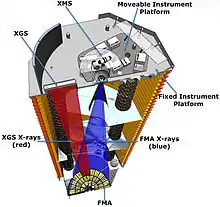International X-ray Observatory
The International X-ray Observatory (IXO) is a cancelled X-ray telescope that was to be launched in 2021 as a joint effort by NASA, the European Space Agency (ESA), and the Japan Aerospace Exploration Agency (JAXA). In May 2008, ESA and NASA established a coordination group involving all three agencies, with the intent of exploring a joint mission merging the ongoing XEUS and Constellation-X projects. This proposed the start of a joint study for IXO.[1][2][3][4][5] NASA was forced to cancel the observatory due to budget constrains in fiscal year 2012. ESA however decided to reboot the mission on its own developing Advanced Telescope for High Energy Astrophysics as a part of Cosmic Vision program.[6][7]
 | |
| Mission type | Space observatory |
|---|---|
| Operator | NASA / ESA / JAXA |
| Website | http://ixo.gsfc.nasa.gov/ |
| Mission duration | 5 years |
| Spacecraft properties | |
| Launch mass | 4,375 kilograms (9,645 lb) |
| Power | 3.7 kilowatts (3,700 W) |
| Start of mission | |
| Launch date | 2021 |
| Rocket | Atlas V or Ariane V |
| Orbital parameters | |
| Reference system | L2 point |
| Regime | 800km |
| Main | |
| Type | X-ray |
| Focal length | 20m |
| Instruments | |
| Hard X-ray Imager, High Timing Resolution Spectrometer, X-ray Grating Spectrometer, X-ray Microcalomiter Spectrometer, X-ray Polarimeter | |
Science with IXO
X-ray observations are crucial for understanding the structure and evolution of the stars, galaxies, and the Universe as a whole. X-ray images reveal hot spots in the Universe—regions where particles have been energized or raised to very high temperatures by strong magnetic fields, violent explosions, and intense gravitational forces. X-ray sources in the sky are also associated with the different phases of stellar evolution such as the supernova remnants, neutron stars, and black holes.[8]
IXO will explore X-ray Universe and address the following fundamental and timely questions in astrophysics:
- What happens close to a black hole?
- How did supermassive black holes grow?
- How do large scale structures form?
- What is the connection between these processes?
To address these science questions, IXO will trace orbits close to the event horizon of black holes, measure black hole spin for several hundred active galactic nuclei (AGN), use spectroscopy to characterize outflows and the environment of AGN during their peak activity, search for supermassive black holes out to redshift z = 10, map bulk motions and turbulence in galaxy clusters, find the missing baryons in the cosmic web using background quasars, and observe the process of cosmic feedback where black holes inject energy on galactic and intergalactic scales.[9][10][11][12]
This will allow astronomers to understand better the history and evolution of matter and energy, visible and dark, as well as their interplay during the formation of the largest structures.
Closer to home, IXO observations will constrain the equation of state in neutron stars, black holes spin demographics, when and how elements were created and dispersed into the intergalactic medium, and much more.[13][14][15]
To achieve these science goals, IXO requires extremely large collecting area combined with good angular resolution in order to offer unmatched sensitivities for the study of the high-z Universe and for high-precision spectroscopy of bright X-ray sources.[16]
The large collecting area required because, in astronomy, telescopes gather light and produce images by hunting and counting photons. The number of photons collected puts the limit to our knowledge about the size, energy, or mass of an object detected. More photons collected means better images and better spectra, and therefore offers better possibilities for understanding of cosmic processes.[8]
IXO configuration
The heart of IXO mission is a single large X-ray mirror with up to 3 square meters of collecting area and 5 arcsec angular resolution, which is achieved with an extendable optical bench with a 20 m focal length.[3][17]
Optics

A key feature of the IXO mirror design is a single mirror assembly (Flight Mirror Assembly, FMA), which is optimized to minimize mass while maximizing the collecting area, and an extendible optical bench.[18]
Unlike visible light, X-rays cannot be focused at normal incidence, since the X-ray beams would be absorbed in the mirror. Instead, IXO's mirrors, like all prior X-ray telescopes, will use grazing incidences, scattering at a very shallow angle. As a result, X-ray telescopes consist of nested cylindrical shells, with their inner surface being the reflecting surface. However, as the goal is to collect as many photons as possible, IXO will have a bigger than 3m diameter mirror.
As the grazing angle is a function inversely proportional to photon energy, the higher-energy X-rays require smaller (less than 2 degrees) grazing angles to be focused. This implies longer focal lengths as the photon energy increases, thus making X-ray telescopes difficult to build if focusing of photons with energies higher than a few keV is desired. For that reason IXO features an extendible optical bench that offers a focal length of 20 m. A focal length of 20 meters was selected for IXO as a reasonable balance between scientific needs for advanced photon collecting capability at the higher energy ranges and engineering constraints. Since no payload fairing is large enough to fit a 20-meter long observatory, thus IXO has a deployable metering structure between the spacecraft bus and the instrument module.
Instruments

IXO scientific goals require gathering many pieces of information using different techniques such as spectroscopy, timing, imaging, and polarimetry. Therefore, IXO will carry a range of detectors, which will provide complementary spectroscopy, imaging, timing, and polarimetry data on cosmic X-ray sources to help disentangle the physical processes occurring in them.[3]
Two high-resolution spectrometers, a microcalorimeter (XMS or cryogenic imaging spectrograph (CIS)) and a set of dispersive gratings (XGS) will provide high-quality spectra over the 0.1–10 keV bandpass where most astrophysically abundant ions have X-ray lines.[19] The detailed spectroscopy from these instruments will enable high-energy astronomers to learn about the temperature, composition, and velocity of plasmas in the Universe. Moreover, the study of specific X-ray spectral features probes the conditions of matter in extreme gravity field, such as around supermassive black holes. Flux variability adds a further dimension by linking the emission to the size of the emitting region and its evolution over time; the high timing resolution spectrometer (HTRS) on IXO will allow these types of studies in a broad energy range and with high sensitivity.[20]
To extend our view of the high-energy Universe to the hard X-rays and find the most obscured black holes, the wide field imaging & hard X-ray imaging detectors (WFI/HXI) together will image the sky up to 18 arcmin field of view (FOV) with a moderate resolution (<150 eV up to 6 keV and <1 keV (FWHM) at 40 keV).[21]
IXO's imaging X-ray polarimeter will be a powerful tool to explore sources such as neutron stars and black holes, measuring their properties and how they impact their surroundings.[22]
The detectors will be located on two instrument platforms—the Moveable Instrument Platform (MIP) and the Fixed Instrument Platform (FIP). The Moveable Instrument Platform is needed because an X-ray telescopes cannot be folded as it can be done with visible-spectrum telescopes. Therefore, IXO will use the MIP that holds the following detectors—a wide field imaging & hard X-ray imaging detector, a high-spectral-resolution imaging spectrometer, a high timing resolution spectrometer, and a polarimeter—and rotates them into the focus in turn.[23]
The X-ray Grating Spectrometer will be located on the Fixed Instrument Platform. This is a wavelength-dispersive spectrometer that will provide high spectral resolution in the soft X-ray band. It can be used to determine the properties of the warm-hot-intergalactic medium, outflows from active galactic nuclei, and plasma emissions from stellar coronae.[24]
A fraction of the beam from the mirror will be dispersed to a charge-coupled device (CCD) camera, which will operate simultaneously with the observing MIP instrument and collect instrumental background data, which can occur when an instrument is not in the focal position.
To avoid interfering the very faint astronomical signals with radiation from the telescope, the telescope itself and all its instruments must be kept cold. Therefore, the IXO Instrument Platform features a large shield that blocks the light from the Sun, Earth, and Moon, which otherwise would heat up the telescope, and interfere with the observations.
IXO optics and instrumentation will provide up to 100-fold increase in effective area for high resolution spectroscopy, deep spectral, and microsecond spectroscopic timing with high count rate capability.[8]
The improvement of IXO relative to current X-ray missions is equivalent to a transition from the 200 inch Palomar telescope to a 22 m telescope while at the same time shifting from spectral band imaging to an integral field spectrograph.
Launch
The planned launch date for IXO was 2021, going into an L2 orbit on either the Ariane V or Atlas V. [3]
Science operations
IXO was designed to operate for a minimum of 5 years, with a goal of 10 years, so IXO science operations were anticipated to last from 2021 to 2030. [3]
See also
References
- NASA. "GCONX". ixo.gsfc.nasa.gov.
- "Announcing the International X-ray Observatory (IXO)". sci.esa.int.
- "The International X-ray Observatory Activity submission in response to the Astro2010 Program Prioritization Panel RFI#1" (PDF).
- "ESA Science & Technology: Documents". 12 December 2012. Archived from the original on 12 December 2012.
- "IXO". ixo.gsfc.nasa.gov.
- NASA. "IXO". ixo.gsfc.nasa.gov.
- "ESA Science & Technology: Athena to study the hot and energetic Universe". ESA. 27 June 2014. Retrieved 23 August 2014.
- NASA. "IXO". ixo.gsfc.nasa.gov.
- "Stellar-Mass Black Holes and Their Progenitors", J. Miller et al.
- "The Evolution of Galaxy Clusters Across Cosmic Time", M. Arnaud et al.
- "The Missing Baryons in the Milky Way and Local Group", Joel N. Bregman et al.
- "Cosmic Feedback from Supermassive Black Holes", Andrew C. Fabian et al.
- "The Behavior of Matter Under Extreme Conditions", F. Paerels et al.
- "Spin and Relativistic Phenomena Around Black Holes", L. Brenneman et al.
- "Formation of the Elements", John P. Hughes et al.
- "The International X-ray Observatory Activity submission in response to the Astro2010 Program Prioritization Panel RFI#1, IXO performance requirements, p. 7" (PDF).
- ""Mechanical Overview of the International X-Ray Observatory", David W. Robinson, IEEE Aerospace Conference, p. 3, 2009" (PDF).
- ""Design Concept for the International X-Ray Observatory Flight Mirror Assembly", Ryan S. McClelland, David W. Robinson, IEEE Aerospace Conference, 2009" (PDF).
- "Uniform high spectral resolution demonstrated in arrays of TES x-ray microcalorimeters", Caroline Kilbourne et al., SPIE 2007
- "Science with the XEUS High Time Resolution Spectrometer", D. Barret, 2008, Proc. SPIE Vol. 7011, 70110E
- Treis, J., et al., 2008, Proc. SPIE Vol. 7021, 70210Z
- "XPOL: a photoelectric polarimeter onboard XEUS", Enrico Costa et al., Proceedings of SPIE Astronomical Instrumentation 2008 Conference, 23–28 June 2008 Marseille, France, Vol. 7011–15
- "Mechanical Overview of the International X-Ray Observatory, David W. Robinson, IEEE Aerospace Conference, 2009" (PDF).
- "Development of a critical-angle transmission grating spectrometer for the International X-Ray Observatory", Ralf K. Heilmann et al., Proc. SPIE Vol. 7437 74370G-8, 2009
External links
| Wikimedia Commons has media related to International X-ray Observatory. |
- NASA International X-Ray Observatory Mission Site
- ESA International X-Ray Observatory Mission Site
- Catherine Cesarsky, International Year of Astronomy 2009 The Universe: Yours to Discover
- ESA - XEUS overview
- ESA - Observations: Seeing in X-ray wavelengths
- Astro2010 Decadal Survey
- 2000-2010 Decadal Survey

